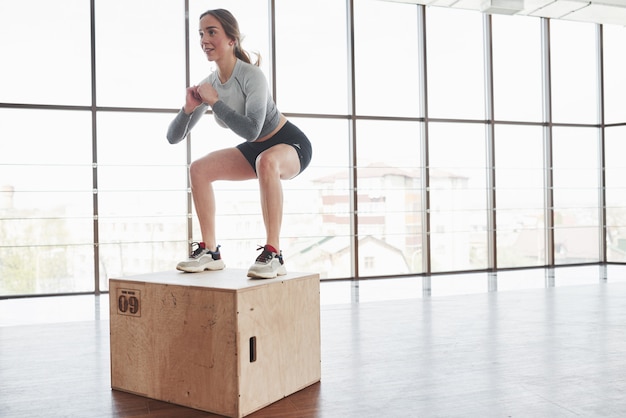
If you’re looking to take your workouts to the next level, plyometric training might be the way to go. Known as “plyos,” this type of exercise helps your muscles become more powerful and responsive, making them work up to ten times faster than usual. With so many benefits, it’s no wonder fitness enthusiasts are eager to try it.
Plyometric training trains both your muscles and mind to perform fast, explosive movements—something you can’t achieve with regular exercise routines. That’s why this method is especially popular among athletes and performers who need to make quick, high-energy moves in just seconds.
Surprisingly, you don’t need to do plyometric exercises every day to see results. Just two sessions per week, with 3 to 5 repetitions, can teach your muscles to perform extraordinary movements with ease. Whether it’s high jumps, squats, running, or lifting weights, plyometric workouts push your muscles to their limits to improve their performance. However, it’s important to note that these exercises focus on muscle power and flexibility rather than calorie burning.
### Top Benefits of Plyometric Exercises
#### 1. Builds Muscular Power
If you want to improve your physical performance—whether in sports, workout routines, or daily activities—it’s essential to focus on muscle power rather than just strength. Plyometric training helps muscles contract faster, boosting their speed and efficiency during demanding activities. With regular practice, your arms and legs become stronger, faster, and more capable of handling tough tasks without overexertion. That’s why kickboxers, who train for muscle power, often outperform traditional bodybuilders when it comes to quick, explosive movements.
#### 2. Strengthens Tendons
Healthy tendons are key to maximizing your muscle fiber’s power and productivity. Plyometric exercises strengthen your tendons, making them more elastic and resilient. This added flexibility reduces the risk of injury, even during intense or repetitive motions.
#### 3. Reduces Injury Risk
Athletes and performers often need their muscles to respond quickly and smoothly under pressure. Plyometric workouts train your body for the fast-twitch muscle contractions needed for high-level performance, so you can make explosive movements without injury. By making muscles and tendons more flexible, plyometric exercises lower the likelihood of strains and fractures, even during demanding activities.
#### 4. Improves Endurance
Plyometric exercises are great for boosting your stamina and energy efficiency. By enhancing muscle endurance, athletes can sustain high-energy performances over longer periods with less difficulty. Aspiring competitors can add plyometric workouts to their routine to preserve energy while improving overall performance.
#### 5. No Equipment Required
One of the best things about plyometric exercises is that you don’t need any special equipment to do them. Unlike workouts that depend on costly gym equipment, you can perform plyos anywhere, anytime, with no additional expense.
#### 6. Supports Calorie Burning
While plyometric exercises don’t directly target calorie burning, they still help you shed fat by boosting your metabolism and building lean muscle. Stronger, larger muscles require more energy to maintain, which helps burn calories even when you’re resting.
#### 7. Enhances Performance in Sports and Other Workouts
Plyometric training improves performance across a variety of sports and workouts. By increasing muscle flexibility and power, you’ll see better results in activities like weightlifting, basketball, soccer, sprinting, and even endurance sports such as marathons. Plyos prepare your body for explosive, short-duration movements and reduce the likelihood of injuries during high-intensity sports.
### Top Plyometric Exercises
Here are a few effective plyometric workouts you can include in your routine:
#### Sumo Squat Jump
This variation of the squat works your inner and outer thighs, abs, and glutes. Start with your feet wider than shoulder-width apart, toes pointed outward, and your core engaged. Lower your torso into a squat. Then, jump up, straighten your legs, and land softly back into the squat position. Repeat 10 to 12 times for the best results.
#### Lunge Jump
A variation of the traditional lunge, this move targets glutes, quads, calves, and hamstrings. Begin in a lunging position with your left leg forward and lower your torso. Jump up, switch legs mid-air, and land softly into another lunge. Complete two sets of 10 repetitions.
#### Squat Jump
Squat jumps focus on strengthening your glutes, hamstrings, quads, and core. Start in a squat position, jump up with force, and land softly back in the squat position. Perform 10 repetitions every few days to build strength in your upper and lower body.
#### Box Jump
This exercise is a step up from the squat jump, requiring you to jump onto a sturdy box or platform. Stand in front of the box, keep your abs tight, and jump up with power. Land softly in a squat position on the box, then stand and jump back onto the ground. Box jumps work your glutes, calves, core, and shoulders.
#### Tuck Jump
Perfect for burning calories and toning your muscles, tuck jumps target your abs, glutes, calves, hamstrings, and quads. Stand straight, flex your knees slightly, and jump as high as you can, bringing your knees to your chest. Land gently and repeat for two sets of 10 reps.
#### Power Skipping
This calorie-burning exercise can be done with or without a jump rope. If using a rope, skip faster and jump higher than usual for 20 to 30 seconds. Without a rope, mimic skipping movements, jumping high with your arms swinging. Variations, like cross-legged skips, also help tone your muscles while boosting your metabolism.
### Final Thoughts
Plyometric exercises are uniquely effective because they rely on a stretch-shortening cycle (SSC) to improve muscle explosiveness. By incorporating plyos into your fitness routine, you’ll not only boost athletic performance but also enhance your physical and mental health. Whether you’re an athlete, casual sports enthusiast, or weightlifter, plyometric training can help you achieve your fitness goals in a dynamic and powerful way.